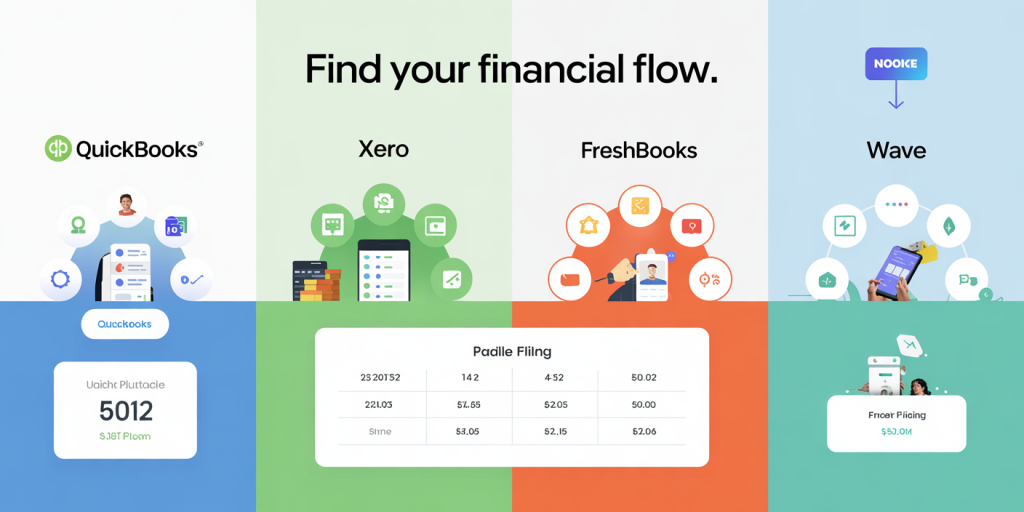Financial Management Software for Small Business Owners
Anúncios
In today’s fast-paced digital economy, small businesses face unique financial challenges that require efficient and reliable management tools. Managing cash flow, invoices, payroll, expenses, and taxes manually can be highly time-consuming and prone to errors. Financial management software offers an effective solution by automating key processes, providing insightful analytics, and improving accuracy. For small business owners, adopting the right financial management software is essential to maintain profitability, ensure compliance, and make strategic decisions.

The proliferation of cloud-based solutions and AI-powered tools has transformed the financial landscape for small enterprises. According to a 2023 survey by Statista, nearly 60% of small business owners now use some form of financial software to streamline operations. This adoption is driven not only by efficiency gains but also by the need to compete effectively in a digitally enabled marketplace. Understanding the features, benefits, and limitations of various financial management software options can empower owners to choose a platform tailored to their specific business needs.
Anúncios
The Importance of Financial Management Software for Small Businesses
Operating a small business involves juggling multiple financial responsibilities simultaneously. From tracking daily sales to preparing monthly financial statements, each task demands accuracy and timeliness. Manual bookkeeping or relying on generic spreadsheets is no longer sufficient to handle the complexity of modern small business finances. Financial management software offers a centralized platform for financial data, reducing errors and saving valuable time.
Additionally, these software programs help small business owners maintain regulatory compliance, especially around tax reporting and labor laws. For instance, Intuit’s QuickBooks automates tax form generation and can integrate directly with tax agencies, vastly simplifying year-end filing. Inaccurate or missed submissions can lead to costly fines and audits, risks that financial software helps mitigate by providing timely alerts and compliance updates.
Practical examples emphasize the material benefits. Consider a small retail store that transitioned from manual invoicing to cloud-based financial software. Within six months, the owner reported a 40% reduction in time spent on financial paperwork while improving invoice collection by 25% due to automated reminders. Such outcomes are replicated across various industries, underscoring how software adoption is increasingly indispensable.

Key Features to Look for in Financial Management Software
Choosing the right financial software depends on the specific needs of the business, yet certain features are universally valuable. Core functionalities usually include expense tracking, invoicing, payroll management, budgeting tools, and financial reporting. Software that also offers seamless bank integration enables automatic transaction recording, which reduces the risk of missing or misclassified expenses.
Automation is another critical feature. For example, features like automatic invoice generation, recurring billing, or tax calculation allow owners to focus on strategic activities rather than routine administrative work. Real-time dashboards provide insights into cash flow, profit margins, and outstanding receivables, empowering owners to make informed decisions. For example, Xero’s cloud-based system offers customizable reports that help business owners track key performance indicators on a daily basis.
Security must not be overlooked. Since financial data is sensitive, software should incorporate robust encryption standards and adhere to regulatory frameworks such as GDPR. Two-factor authentication and role-based access controls further enhance security in multi-user environments.
Here is a comparative table showcasing some popular financial management software features relevant to small businesses:
| Feature | QuickBooks Online | Xero | FreshBooks | Wave |
|---|---|---|---|---|
| Bank Account Integration | Yes | Yes | Yes | Yes |
| Automated Invoice Reminders | Yes | Yes | Yes | Yes |
| Payroll Management | Add-on | Paid Add-on | Included | Limited |
| Tax Calculations & Filing | Yes | Yes | No | No |
| Mobile Access | Yes | Yes | Yes | Yes |
| Budgeting Tools | Basic | Advanced | Basic | Limited |
| Multi-currency Support | Yes | Yes | Yes | No |
| Free Plan Available | No | No | No | Yes |
Benefits of Automated Financial Management
Automation in financial management software greatly enhances accuracy and efficiency. By reducing human intervention, these systems minimize the common errors that occur in manual bookkeeping, such as duplicate entries or missed transactions. Small businesses frequently deal with fluctuating cash flows and tight budgets, and having up-to-date financial data is crucial to maintaining operational stability.
Beyond error reduction, automation facilitates better cash flow management. According to a U.S. Bank study, 82% of small businesses fail due to poor cash flow management. Financial software that automates payment reminders or generates financial forecasts helps businesses anticipate potential shortfalls and take preemptive action. For instance, a service provider using software like FreshBooks can automate billing cycles, ensuring timely client payments and improving liquidity.
Automation also helps with tax preparation by automatically categorizing expenses and generating necessary reports. This can reduce end-of-year accounting costs by up to 30%, based on industry reports from the National Small Business Association (NSBA). Furthermore, integration with tax filing platforms streamlines submissions, reducing the risk of penalties.
Real-World Case Studies Demonstrating Impact
Many small business owners have experienced significant improvements in financial management after adopting specialized software. For example, Jane Watson, owner of a boutique digital marketing agency in Austin, Texas, struggled for years with fragmented financial information scattered across spreadsheets and emails. After implementing QuickBooks Online, Jane reported a 50% reduction in financial reconciliation time and was able to identify unprofitable clients through detailed profit-and-loss reporting.
Another example is Rebel Auto Repair, a small garage in Atlanta, which switched from manual invoicing to using Xero’s automated billing system. The transition resulted in faster invoice generation and collection, improving monthly revenue by nearly 18%. Through Xero’s bank feed feature, Rebel Auto Repair was able to identify unnecessary overhead expenses and reduce them by 12%, increasing overall profitability.
These examples illustrate how financial management software can transform business operations, providing transparency and actionable insights that manual methods cannot easily match. The ability to generate customized reports also enables owners to communicate financial performance and future projections effectively to stakeholders such as investors or lenders.
Cost Considerations and Pricing Models
Financial management software pricing varies significantly depending on features, user count, and service models. Small businesses must carefully evaluate cost structures to find software that balances affordability and functionality. Monthly subscriptions dominate the market, often ranging from $10 to $70 per month for most small business packages.
For startups and businesses on a tight budget, free software options such as Wave provide essential functionalities including invoicing and expense tracking without licensing fees. However, free plans often lack advanced reporting, multi-user support, or payroll integrations, which can be critical as the business grows.
Mid-tier platforms like QuickBooks Online or Xero offer scalable pricing plans with more comprehensive tools, including tax filing support and inventory management. Businesses anticipating growth often benefit from these platforms, paying between $25 and $50 monthly. It’s essential to factor in potential add-on costs, such as payroll services or third-party integrations, which may increase the total expense.
Here is a simplified breakdown of typical pricing for popular platforms:
| Platform | Basic Plan Cost (Monthly) | Mid-Tier Plan Cost (Monthly) | Payroll Add-on Cost |
|---|---|---|---|
| QuickBooks Online | $25 | $70 | $45+ |
| Xero | $30 | $60 | $40+ |
| FreshBooks | $15 | $50 | Included (higher plan) |
| Wave | Free | N/A | $20+ |
Businesses should also consider the total cost of ownership, including possible training, migration, and support services. Investing in well-supported software can reduce hidden costs associated with inefficient processes and data errors.
Future Perspectives in Financial Management Software
The evolution of financial management software continues to integrate advanced technologies such as artificial intelligence (AI), machine learning, and blockchain. These innovations promise to further simplify financial tasks and enhance predictive analytics by providing real-time financial health assessments and personalized cash flow recommendations.
For instance, AI-powered tools can automatically categorize transactions with increasing accuracy, identify anomalies indicating fraud, or suggest cost-saving opportunities based on spending patterns. As AI algorithms improve, small business owners can expect more proactive, data-driven decision support within their financial platforms.
Blockchain technology offers the potential for enhanced transaction transparency and security, especially useful in multi-party payments or contract management. While still emerging for small business applications, blockchain-based financial management could reduce fraud risks and ensure tamper-proof records.
Moreover, mobile-first financial apps are becoming the norm, supporting remote business management and integration across various platforms, from accounting and CRM to payment solutions. As small businesses grow increasingly global, multi-currency and localization features will become essential components of software solutions.

The rise of Software-as-a-Service (SaaS) models combined with AI integrations indicates a future where financial management is more automated, intuitive, and scalable, enabling even solo entrepreneurs to manage complex finances effortlessly.
